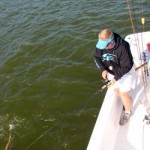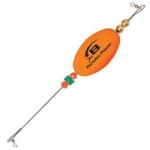from The Fishing Wire
Barnie White and his partner Chad Dufrene were named champions of the 2013 IFA Grand Isle Redfish Event on Sunday, Aug. 25. For the win, the team takes home a fully rigged Ranger Banshee Extreme powered by a Yamaha Outboard, valued at $30,000, and qualified to fish the Series Championship Oct. 25-26.
When sight fishing is tough, breaking out the noise-makers can be the trick to luring fat Louisiana redfish.
To win the tournament, each team weighed in two fish under the Louisiana maximum length of 27 inches, so beyond just catching fish, teams must catch fish as close to the maximum length as possible while releasing any overs. White and Dufrene weighed in two fish for 16.47 pounds.
The morning began with rain and wind, which continued throughout the day. Not only did the conditions make fishing more difficult, but it also slowed travel and prompted the team to fish a back-up area closer to weigh-in.
“The spot we actually started fishing was our backup spot in Venice,” White said. “Conditions just went from bad to worse. We had torrential rain and heavy wind and decided to stay closer. It saved us about 2 hours of fishing time.”
The team started out throwing jigs with soft-plastics suspended under a Paradise Popper Xtreme popping cork. Sight-fishing these redfish was impossible because of the heavy cloud cover, rain and waves. Those same conditions also make it more difficult for the fish to feed, so the anglers needed extra noise and surface disturbance for attraction.
The Paradise Popper X-Treme from Bomber imparts unique action to jigs and adds lots of noise to get the fish’s attention.The Paradise Popper Xtreme features a deep concave face that produces a big splash when twitched, plus two brass beads on top and three specialized plastic beads on bottom. The beads click together to simulate the sound of shrimp popping. The wire that runs through the unit is high-grade titanium, which resists bending or kinking and is up to the task of catching multiple big bull reds without failure.
“Cheap popping corks don’t hold up as well,” White said. “The Popper Xtreme makes a lot of noise, a lot of ripples on the water, produces the right sound, and can handle big redfish all day long.”
One key to that popping cork’s longevity and consistence is two metal grommets, one at the top and the other at the bottom of the foam cork. These grommets prevent the wire from cutting into the cork and diminishing the sound.
Another important factor for fishing a popping cork in low-light conditions is leader length. While many anglers use leaders 2-feet long or longer, White keeps his leaders at around a foot.
“Shorter leaders work for two reasons,” White said. “If you’re fishing a long leader, fish can swallow the jig easier without you knowing it, and we have to keep these fish alive. If a fish hits on a short leader you know it immediately. The other reason is that fish are drawn to the sound of the cork, so you want the jig where they immediately see it when they come in to investigate. You don’t want to make them hunt for it, especially in low-light conditions.”
Barnie White and Chad Dufrene found a pair of “toads”, super fat reds that earned them some $30,000 in prizes.
Another factor to the team’s success was matching the size and colors of the baitfish the reds were feeding on. Using a glow-color, 4-inch plastic and glow jighead created the appearance of a small pogy. White says that anglers need to take into consideration the light level and water clarity when selecting colors. If the light level is low and the water stained, the fish need all the help they can get seeing the bait, making black or glow-colors more important than matching the exact colors on the prevalent baitfish.
“If you cut the lights out at night in my shed where I’ve got glow-colored plastics and jigheads hanging up, you can see them,” he said. “I know in darker conditions when the water’s a little murky, I know that bait is putting off some light.”
White said the team started catching fish immediately that morning, and had 14 1/2-pounds in the livewell within 45 minutes. Considering the weather and knowing they had enough weight to be in the race, the team headed back to weigh-in with several hours of fishing time remaining.

